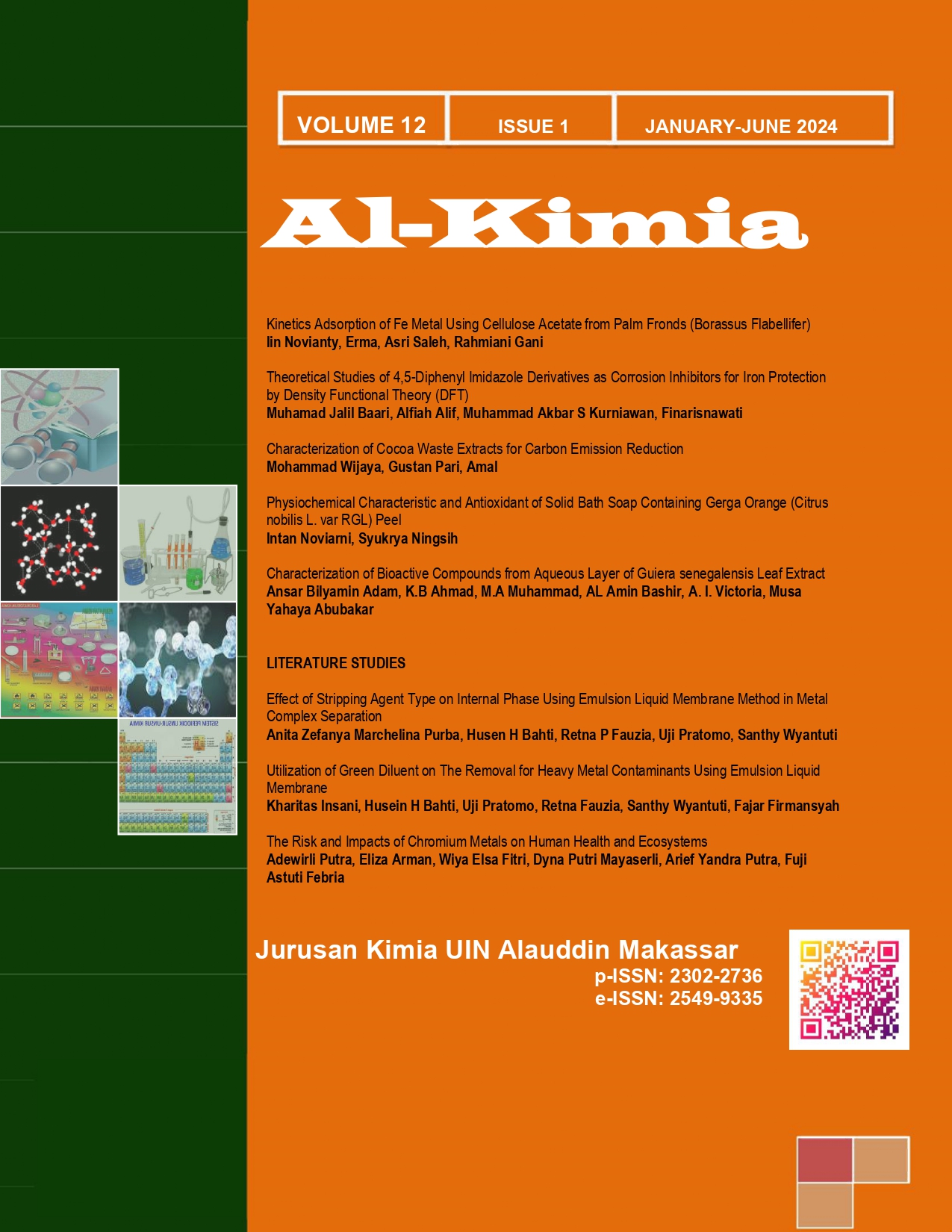Characterization of Bioactive Compounds from Aqueous Layer of Guiera senegalensis Leaf Extract
Abstract
There is need to have cost-effective treatment strategy by using medicinal plant that have therapeutic potentials against varieties of disease due to presence of bioactive compound. The study aimed to characterize the bioactive compounds from the aqueous layer of Guiera senegalensis leaf extracts. Aqueous layer extracts from Guiera senegalensis leaf were prepared and analyzed using FTIR and GCMS. The GCMS result of the plant extract reveals the presence of Carboxylic acid and its derivatives and other compounds such as n-Propyl 11-octadecenoate , Aspidospermidin-17-ol, 1-acetyl-19,21-epoxy-15,16-dimethoxy- . The results of the study have justified therapeutic potential of Guiera senegalensis plant extract. FTIR result indicate a signal at 3205 cm-1which is a vigorous intensity which is attributed to carboxylic acid, a strong signal was observed at 2926 cm-1which is attributed to C-H stretch (alkane),carbon-oxygen (C-O) band was observed at 1200 cm-1 which is attributed to ester, carboxylic acid or ether and aromatic functional carbon-carbon double bond at 1442 cm1, a strong intensity was observed at 1602 cm-1, which is attributed to N-H bend of primary amine, aromatic ring stretch at 1457 cm-1 was also observed with medium intensity. Alkane bend vibration was observed at 1375cm-1, and a strong signal was observed at 1162cm-1, which is attributed to C-N (Amine).
Downloads
References
Adam, A. B., Mohammed, A. D., & Kaugama, A. A. (2022). Extraction and Modification Of Cellulose From Calotropis Procera Plant. International Conference on Chemical and Biological Sciences.
Adedapo AA, Sofidiya MO, Afolayan AJ(2009): Antiinflammatory and analgesic activities of the aqueous extracts of Margaritariadiscoidea (Euphorbiaceae) stem bark in experimental animal models. (Int J Trop Biol,; 57(4): 1193-1200.
Ansari J. A, & Inamdar N. N (2010). The promise of traditional medicines. International Journal of Pharmacognosy.;6:808-812.
Alamgir, A. N. M., & Alamgir, A. N. M. (2018). Phytoconstituents—Active and inert constituents, metabolic pathways, chemistry and application of phytoconstituents, primary metabolic products, and bioactive compounds of primary metabolic origin. Therapeutic Use of Medicinal Plants and their Extracts: Volume 2: Phytochemistry and Bioactive Compounds, 25-164.
Bourgaud, F., Gravot, A., Milesi, S., & Gontier, E. (2001). Production of plant secondary metabolites: a historical perspective. Plant science, 161(5), 839-851.
Dambatta S. H, & Aliyu B. S. (2011). A Survey of Major ethno-medicinal Plants of Kano North, Nigeria, Their Knowledge and Uses by Traditional Healers. Bayero Journal of Pure and Applied Sciences.;4(2):28 34.
Duraipandiyan, V., Ayyanar, M. and Ignacimuthu, S. (2006). Antimicrobial activity of some ethnomedicinal plants used by Paliyar tribe from Tamil Nadu, India. BMC Complementary Altern. Med. 6: 35-41.
Etkin, N. L., & Ross, P. J. (1982). Food as medicine and medicine as food: an adaptive framework for the interpretation of plant utilization among the Hausa of northern Nigeria. Social Science & Medicine, 16(17), 1559-1573.
Jigam A. A, Akanya HO, Dauda BE, Ogbadoyi EO. (2011)Antiplasmodial, analgesic and anti-inflammatory effects of crude Guiera senegalensis Gmel (Combretaceae) leaf extracts in mice infected with Plasmodium berghei. Journal of Pharmacognosy and Phytotherapy. 3(10):150-154.
Mohammed S.Y. (2013): Quantitative phytochemical and elemental analysis of Guiera senegalensis leaf extract. Journal of Pharmacognosy and Phytotherapy.;5(12):204-207.
Shittu, A. M., Ansar, B. A., Ushie, O. A., Ahmad, K. B., Abdullahi, J. A., & Nasir, A. M. (2022). Phytochemical Screening of Lettuce, Spring onion and Spinach cultivated at Farin Gada Farm Land. Tropical journal of engineering, science and technology, 2(1), 45-48.
Authors who publish with this journal agree to the following terms:
1) Authors retain copyright and grant the journal right of first publication with the work simultaneously licensed under a Creative Commons Attribution License that allows others to share the work with an acknowledgement of the work's authorship and initial publication in this journal.
2) Authors are able to enter into separate, additional contractual arrangements for the non-exclusive distribution of the journal's published version of the work (e.g., post it to an institutional repository or publish it in a book), with an acknowledgement of its initial publication in this journal.
3)Authors are permitted and encouraged to post their work online (e.g., in institutional repositories or on their website) prior to and during the submission process, as it can lead to productive exchanges, as well as earlier and greater citation of published work (See The Effect of Open Access).


